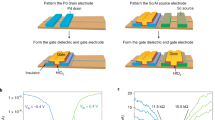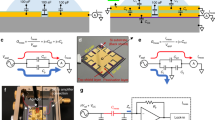Abstract
The miniaturization of electronic devices has been the principal driving force behind the semiconductor industry, and has brought about major improvements in computational power and energy efficiency. Although advances with silicon-based electronics continue to be made, alternative technologies are being explored. Digital circuits based on transistors fabricated from carbon nanotubes (CNTs) have the potential to outperform silicon by improving the energy–delay product, a metric of energy efficiency, by more than an order of magnitude. Hence, CNTs are an exciting complement to existing semiconductor technologies1,2. Owing to substantial fundamental imperfections inherent in CNTs, however, only very basic circuit blocks have been demonstrated. Here we show how these imperfections can be overcome, and demonstrate the first computer built entirely using CNT-based transistors. The CNT computer runs an operating system that is capable of multitasking: as a demonstration, we perform counting and integer-sorting simultaneously. In addition, we implement 20 different instructions from the commercial MIPS instruction set to demonstrate the generality of our CNT computer. This experimental demonstration is the most complex carbon-based electronic system yet realized. It is a considerable advance because CNTs are prominent among a variety of emerging technologies that are being considered for the next generation of highly energy-efficient electronic systems3,4.
This is a preview of subscription content, access via your institution
Access options
Subscribe to this journal
Receive 51 print issues and online access
$199.00 per year
only $3.90 per issue
Buy this article
- Purchase on Springer Link
- Instant access to full article PDF
Prices may be subject to local taxes which are calculated during checkout




Similar content being viewed by others
References
Franklin, A. D. et al. Sub-10 nm carbon nanotube transistor. Nano Lett. 12, 758–762 (2012)
Wei, L., Frank, D., Chang, L. & Wong, H.-S. P. in Proc. 2009 IEEE Intl Electron Devices Meeting 917–920 (IEEE, 2009)
Chang, L. in Short Course IEEE Intl Electron Devices Meeting (IEEE, 2012)
Nikonov, D. & Young, I. in Proc. 2012 IEEE Intl Electron Devices Meeting 24–25 (IEEE, 2012)
Javey, A., Guo, J., Wang, Q., Lundstrom, M. & Dai, H. Ballistic carbon nanotube transistors. Nature 424, 654–657 (2003)
Javey, A., Wang, Q., Kim, W. & Dai, H. in 2003 Intl Electron Devices Meeting Tech. Digest 31–32 (IEEE, 2003)
Appenzeller, J. Carbon nanotubes for high-performance electronics—progress and prospect. Proc. IEEE 96, 201–211 (2008)
Deng, J. et al. in Proc. 2007 IEEE Intl Solid State Circuits Conf. 70–78 (IEEE, 2007)
Iijima, S. Helical microtubules of graphitic carbon. Nature 354, 56–58 (1991)
Martel, R. A. ., Schmidt, T., Shea, H. R., Hertel, T. & Avouris, P. Single-and multi-wall carbon nanotube field-effect transistors. Appl. Phys. Lett. 73, 2447 (1998)
Tans, S. J., Verschueren, A. R. & Dekker, C. Room-temperature transistor based on a single carbon nanotube. Nature 393, 49–52 (1998)
Chen, Z. et al. An integrated logic circuit assembled on a single carbon nanotube. Science 311, 1735 (2006)
Cao, Q. et al. Medium-scale carbon nanotube thin-film integrated circuits on flexible plastic substrates. Nature 454, 495–500 (2008)
Patil, N., Lin, A., Myers, E. R., Wong, H.-S. P. & Mitra, S. in Proc. Symp. VLSI Tech. 205–206. (2008)
Patil, N. et al. Scalable carbon nanotube computational and storage circuits immune to metallic and mis-positioned carbon nanotubes. IEEE Trans. NanoTechnol. 10, 744–750 (2011)
Shulaker, M. et al. in Proc. 2013 IEEE Intl Solid State Circuits Conf. 112–113 (IEEE, 2013)
von Neumann, J. First draft of a report on the EDVAC. Ann. Hist. Comput. 15, 27–75 (1993)
McCluskey, E. J. Logic Design Principles with Emphasis on Testable Semicustom Circuits (Prentice-Hall, 1986)
Cao, Q. et al. Arrays of single-walled carbon nanotubes with full surface coverage for high-performance electronics. Nature Nanotechnol. 8, 180–186 (2013)
Zhang, J. et al. Robust digital VLSI using carbon nanotubes. IEEE Trans. CAD 31, 453–471 (2012)
Patil, N. Design and Fabrication of Imperfection-Immune Carbon Nanotube Digital VLSI Circuits. PhD thesis, Stanford Univ. (2010)
Patterson, D. A. & Hennessy, J. L. Computer Architecture (Kaufmann, 1990)
Lin, A. Carbon Nanotube Synthesis, Device Fabrication, and Circuit Design for Digital Logic Applications. PhD thesis, Stanford Univ. (2010)
Herken, R., ed. The Universal Turing Machine: A Half-Century Survey (Springer, 1995)
Nürnberg, P., Uffe, W. & Hicks, D. A grand unified theory for structural computing. Metainformatics 3002, 1–16 (2004)
Jeffay, K., Donald, S. F. & Martel, C. U. in Proc. Real-Time Systems Symposium 129–139 (IEEE, 1991)
Shulaker, M. et al. Linear increases in carbon nanotube density through multiple transfer technique. Nano Lett. 11, 1881–1886 (2011)
Bachtold, A., Hadley, P., Nakanishi, T. & Dekker, C. Logic circuits with carbon nanotube transistors. Science 294, 1317–1320 (2001)
Collins, P. G., Arnold, M. S. & Avouris, P. Engineering carbon nanotubes and nanotube circuits using electrical breakdown. Science 292, 706–709 (2001)
Patil, N. et al. in Proc. 2009 IEEE Intl Electron Devices Meeting 573–576 (IEEE, 2009)
Acknowledgements
We acknowledge the support of the NSF (CISE) (CNS-1059020, CCF-0726791, CCF-0702343, CCF-0643319), FCRP C2S2, FCRP FENA, STARNet SONIC and the Stanford Graduate Fellowship and the Hertz Foundation Fellowship (M.M.S.). We also acknowledge Z. Bao, A. Lin, H. (D.) Lin, M. Rosenblum, and J. Zhang for their advice and collaborations.
Author information
Authors and Affiliations
Contributions
M.M.S. led and was involved in all aspects of the project, did all of the fabrication and layout designs, and contributed to the design and testing. G.H. wrote the SUBNEG and testing programs, and contributed to the design and testing. N.P. contributed to the design, and N.P., H.W. and H.-Y.C. contributed to developing fabrication processes. H.-S.P.W. and S.M. were in charge and advised on all parts of the project.
Corresponding author
Ethics declarations
Competing interests
The authors declare no competing financial interests.
Extended data figures and tables
Extended Data Figure 1 Fabrication flow for the CNT computer.
Steps 1–4 prepare the final substrate for circuit fabrication. Steps 5–8 transfer the CNTs from the quartz wafer (where highly aligned CNTs are grown) to the final SiO2 substrate. Steps 9–11 continue final device fabrication on the final substrate.
Extended Data Figure 2 Multibit arithmetic unit.
a, Schematic of a two-bit arithmetic unit, comprising six individual arithmetic logic units (ALU) as shown in Fig. 3b. b, Measured and expected output waveforms testing all possible input combinations of the two-bit arithmetic unit, showing correct operation.
Extended Data Figure 3 Internal versus external connections of CNT computer.
a, Schematic of the CNT computer, showing that all connections are fabricated on-chip and that only signals reading or writing to or from an external memory are connected off-chip. b, SEM of the CNT computer, showing which connections are made to and from the CNT computer from the probe pads. The SEM is colour-coded to match the coloured wires in a.
Extended Data Figure 4 PMOS-only logic schematics.
a, Schematic of PMOS-only inverter. b, Schematic of PMOS-only NAND gate.
Rights and permissions
About this article
Cite this article
Shulaker, M., Hills, G., Patil, N. et al. Carbon nanotube computer. Nature 501, 526–530 (2013). https://doi.org/10.1038/nature12502
Received:
Accepted:
Published:
Issue Date:
DOI: https://doi.org/10.1038/nature12502
This article is cited by
-
Highly selective growth of (6,5) single-walled carbon nanotubes from sigma phase alloy catalyst
Nano Research (2024)
-
Chirality-dependent electrical transport properties of carbon nanotubes obtained by experimental measurement
Nature Communications (2023)
-
The future transistors
Nature (2023)
-
Pushing carbon nanotube circuits below the 10-nm node
Nature Electronics (2023)
-
Scaling aligned carbon nanotube transistors to a sub-10 nm node
Nature Electronics (2023)
Comments
By submitting a comment you agree to abide by our Terms and Community Guidelines. If you find something abusive or that does not comply with our terms or guidelines please flag it as inappropriate.



